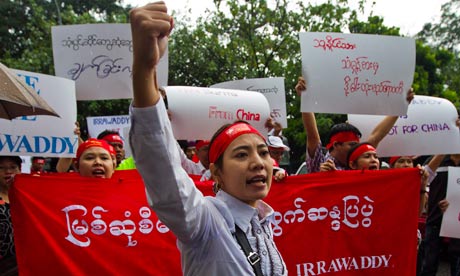BURMA
Villagers Displaced by [Chinese] Myitsone Dam Face Legal Limbo




RANGOON — Nearly five years after their forced relocation from the site of the suspended Myitsone dam project in northern Burma, residents of more than four villages are still legally prohibited from returning to their former homes.
In 2010, the villagers were relocated to a new “model village” seven miles away called Aung Myin Tha, when China Power Investment (CPI) began work on the 4,600 megawatt hydropower project at the source of the Irrawaddy River in conflict-torn Kachin State.
The controversial project was suspended in early 2011, not to be resumed until the end of President Thein Sein’s term in 2016. Despite the suspension, those displaced were not allowed to return to their land and livelihoods.
Some of them went back anyway, the villagers couldn’t farm in their new environs, where the soil quality was poor. This caused many to rely on charity from CPI, which in turn reportedly used rice rations as a form of leverage against critical voices.
Local activists told The Irrawaddy that about 100 households from Tan Hpre, a village seated in the fertile confluence of the Mali Hka and Nmai Hka tributaries, returned to their former homes and farms.
About two weeks ago, village leaders received a letter from Myitkyina Township authorities demanding that they sign a statement acknowledging that they had no right to use the vacant property and could be evicted in the event that development resumes. Earlier this week, local authorities visited the returnees to obtain the signatures, but all of the residents refused to sign the document.
“Last Sunday, Myitkyina local authorities came to Tan Hpre and asked the villagers to sign off on knowing that they have to move when development projects resume,” said Ja Hkawn, a 50-year-old ethnic Kachin activist from the village.
In the years since their relocation, Ja Hkawn has been a vocal critic of the Myitsone dam and a core member of Mungchying Rawt Jat (MRJ), a rights group established by landless Kachin farmers.
“We didn’t sign it because we don’t want to move again,” she told The Irrawaddy. “We can’t find work there [in Aung Myin Tha].”
Bauk Ja, a renowned Kachin land rights activist and member of the National Democratic Force political party, echoed claims that the villagers were unable to make a living at the relocation site, and that returning to their former homes was “logical.”
“Most villagers couldn’t make money in Aung Myin Tha,” Bauk Ja said. “As long as there’s no project [in Tan Hpre], they don’t want to move away again.”
A lawmaker representing Myitkyina, Hkyet Hting Nan of the ruling Union Solidarity and Development Party, told The Irrawaddy that those who returned have been tolerated by authorities but will ultimately be legally obligated to leave.
“We know that villagers in Tan Hpre have their own farms and don’t want to live in the new village, but by law they are not allowed to go back. The dam project is not stopped, it is suspended, and it could resume after 2015,” Hkyet Hting Nan said. “They can stay right now, but after this year we’re not sure.”
A memorandum of understanding for the development of the Myitsone dam project was reached in 2006 between Burma’s Ministry of Electric Power, domestic developer Asia World Co. and China’s state-owned CPI.
The project was suspended in 2011 amid mounting public criticism and the resumption of armed conflict in the state, which for the 17 years prior had maintained a ceasefire with the government.
No comments:
Post a Comment
Comments always welcome!